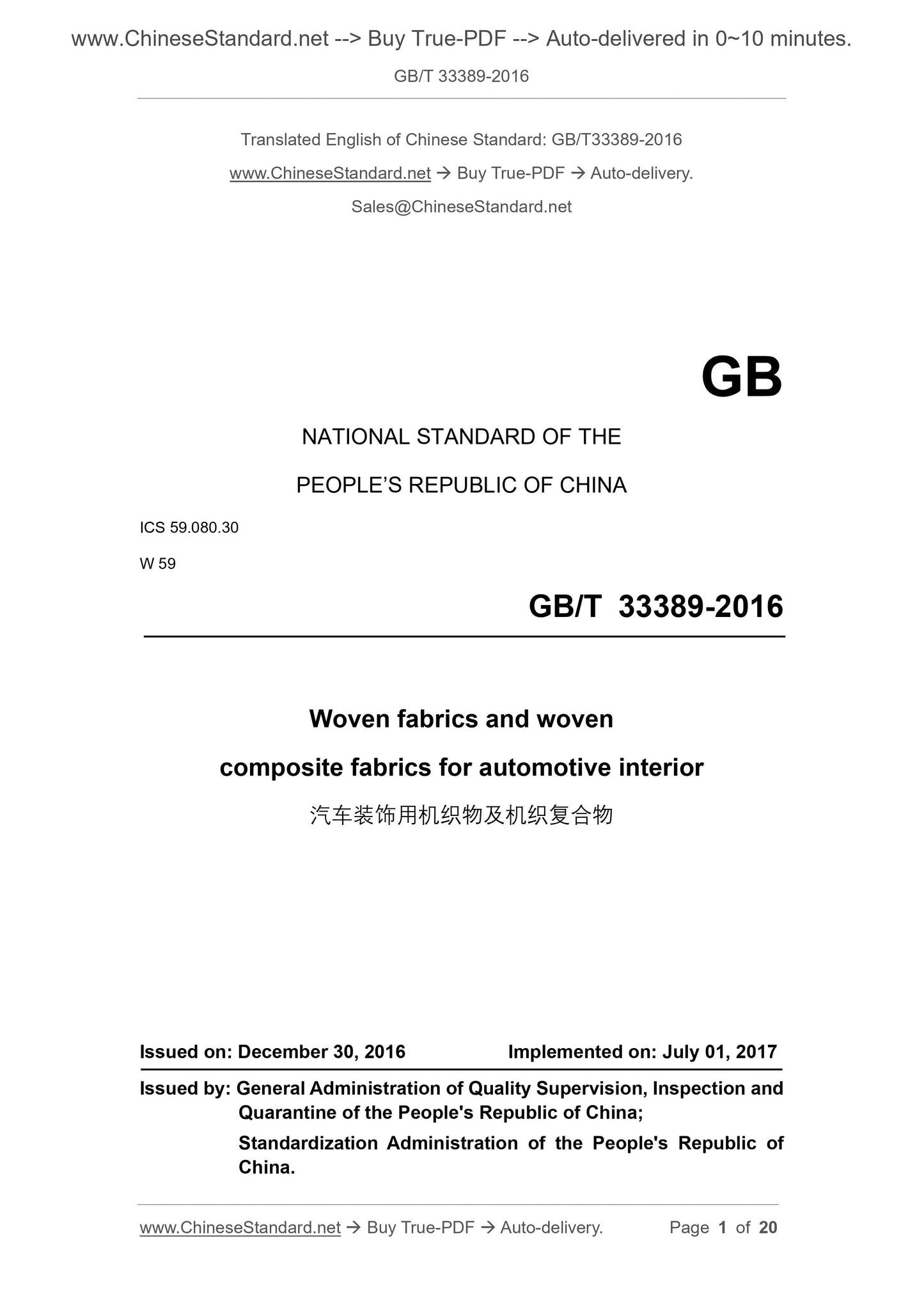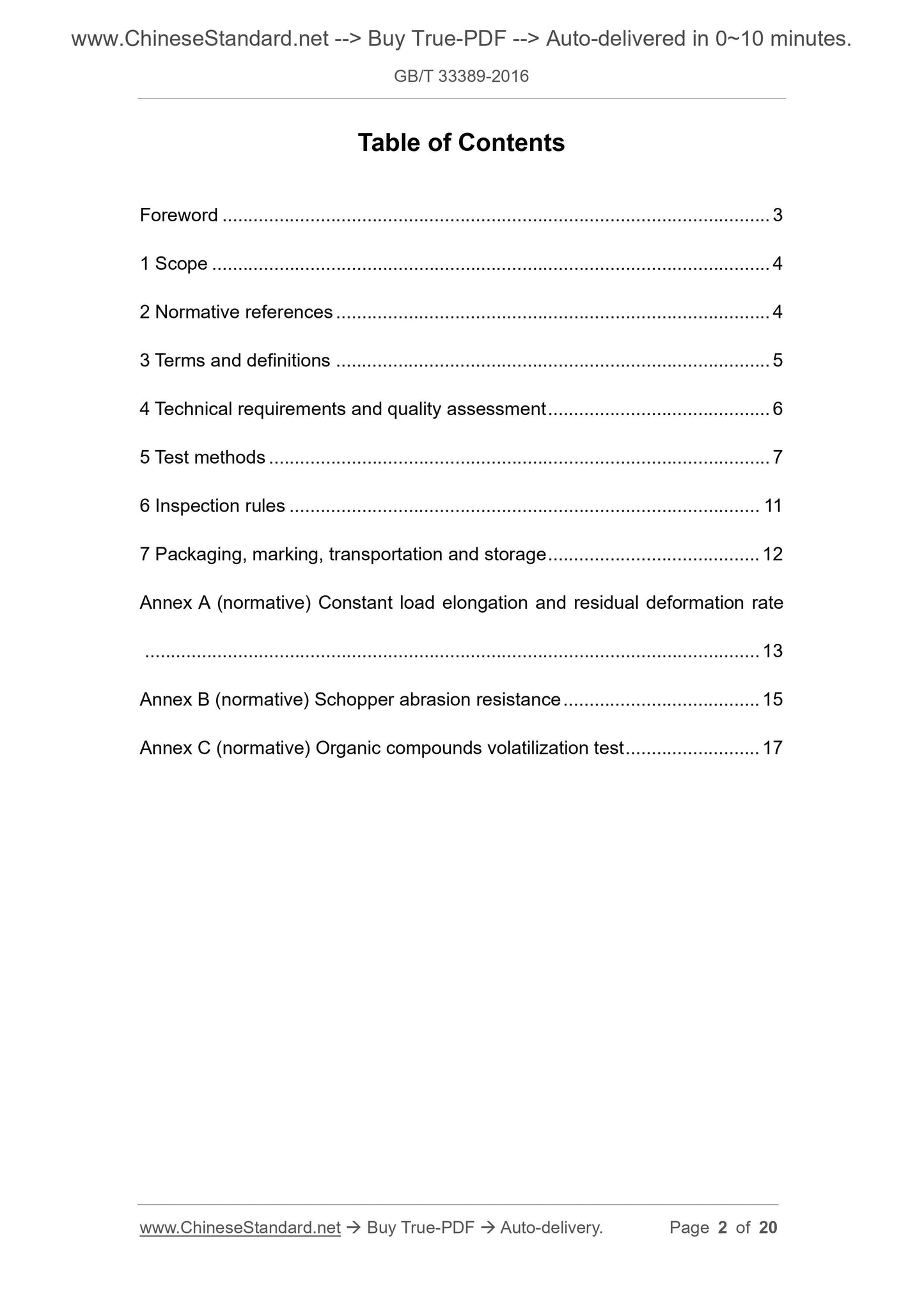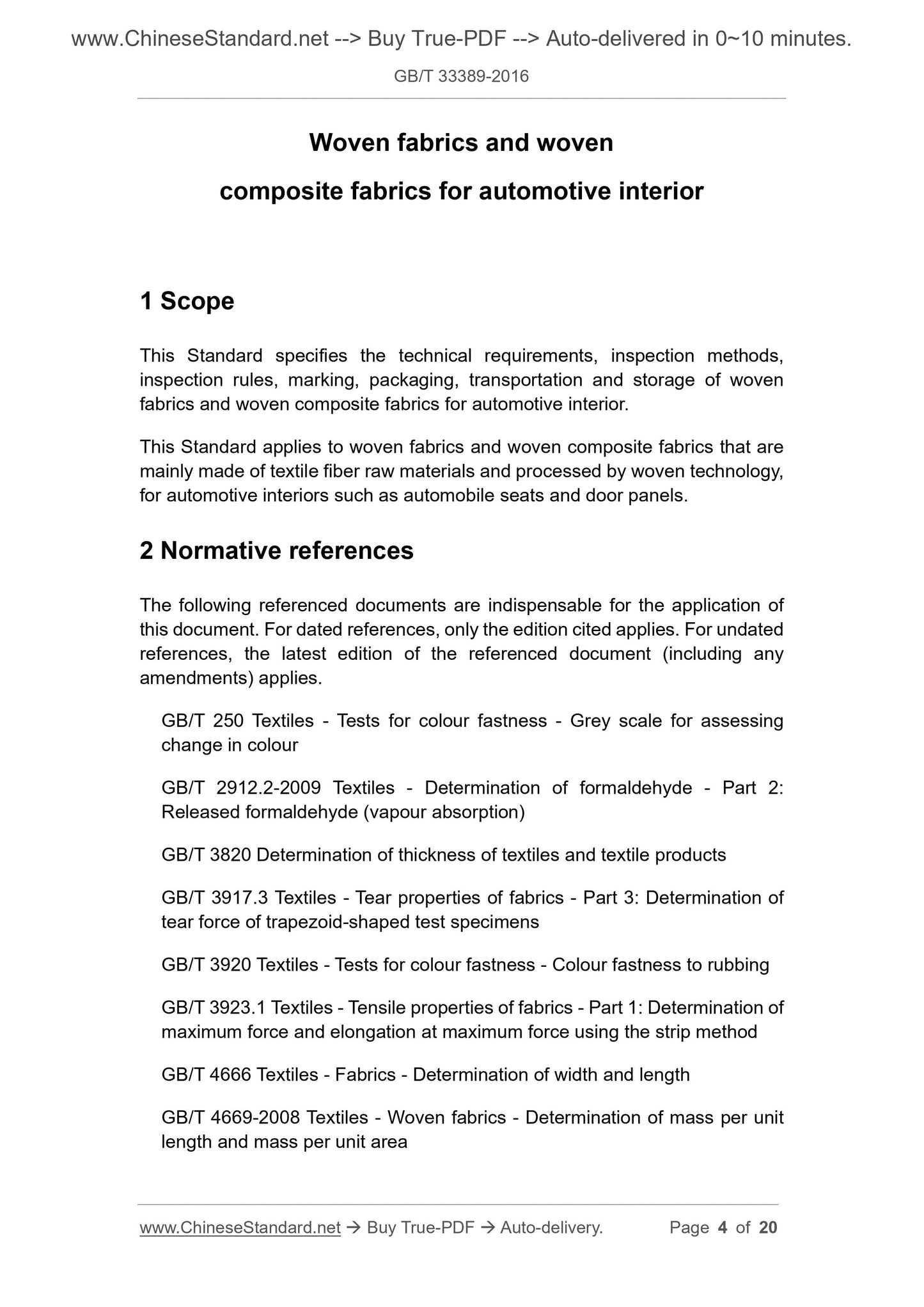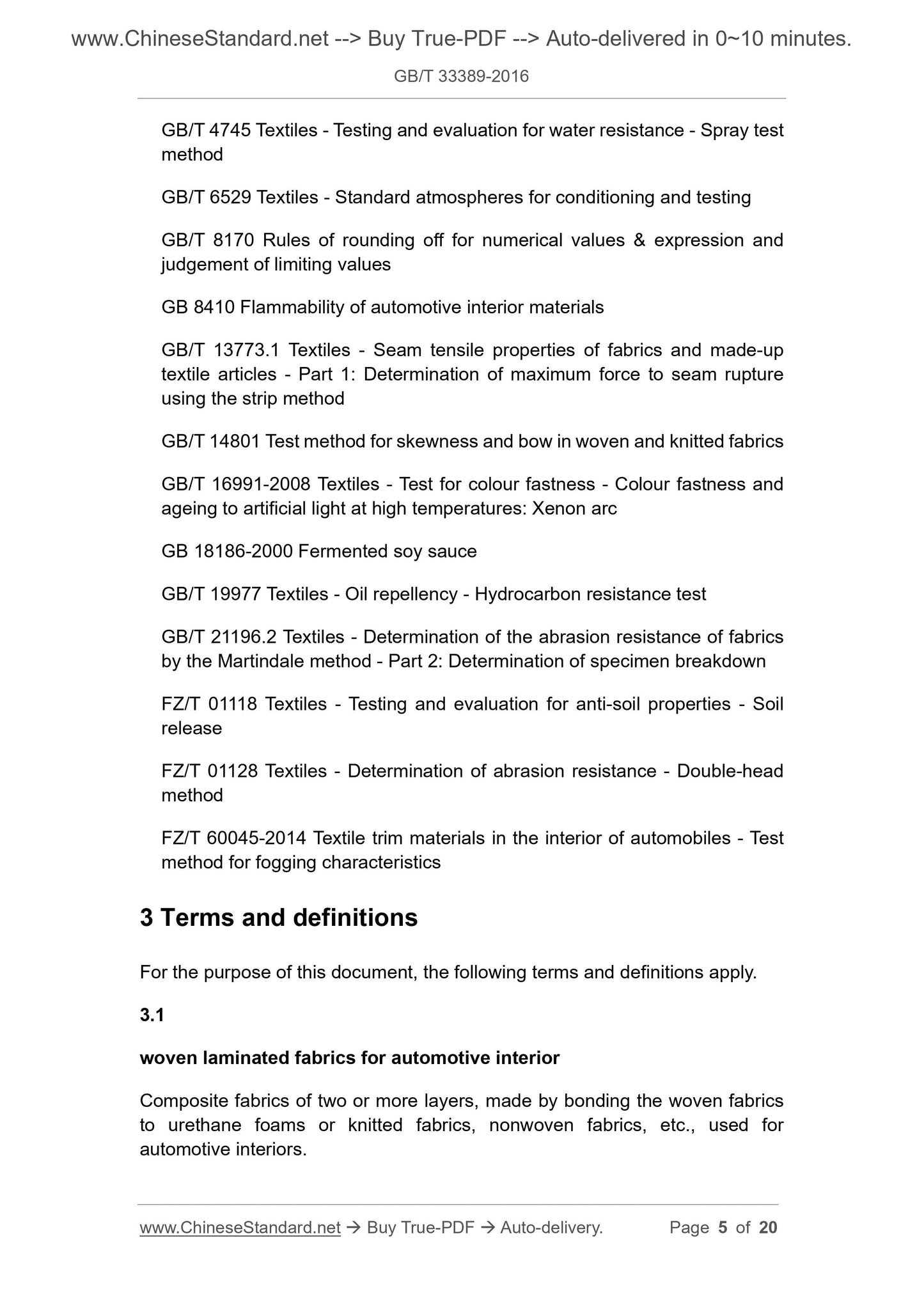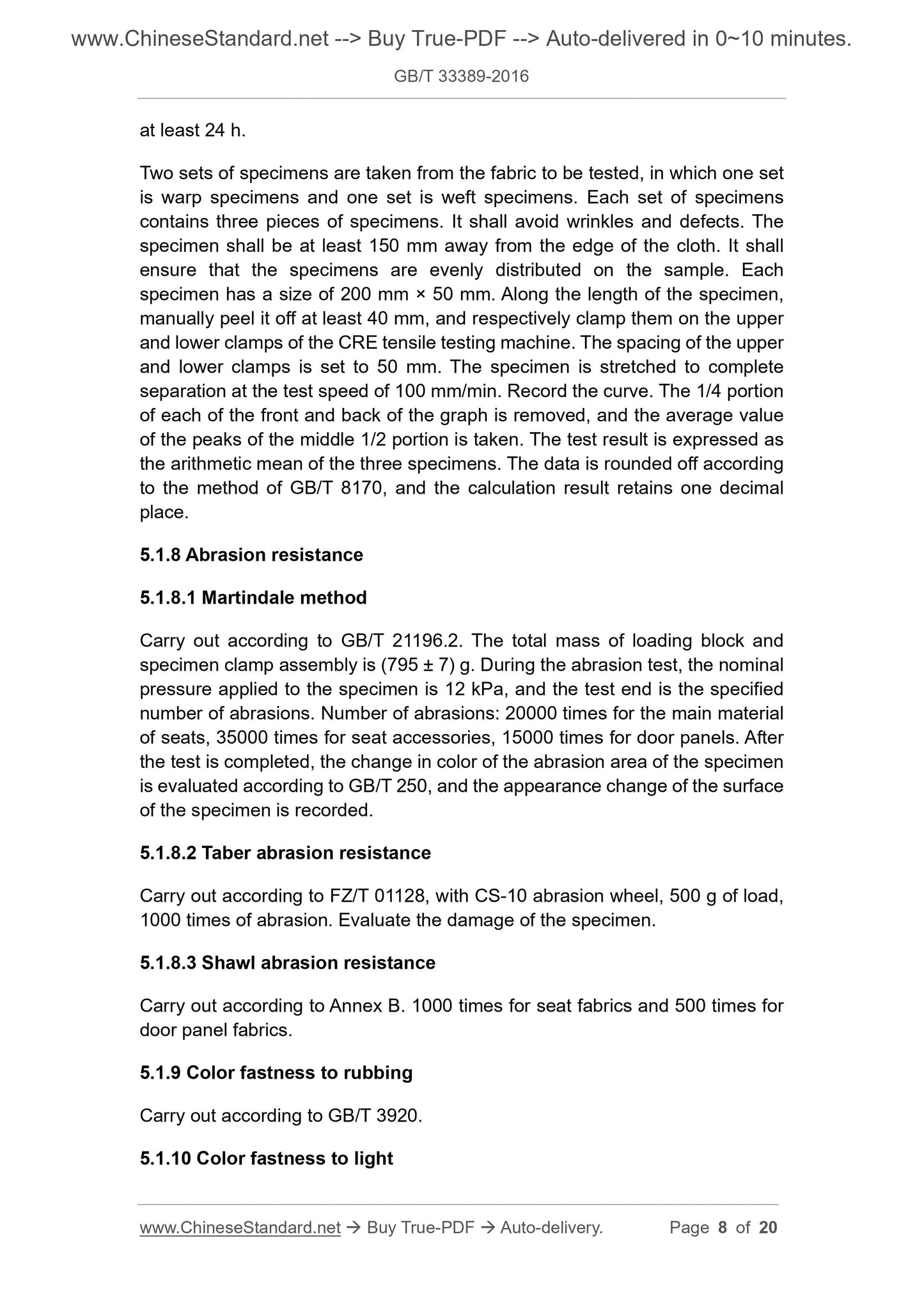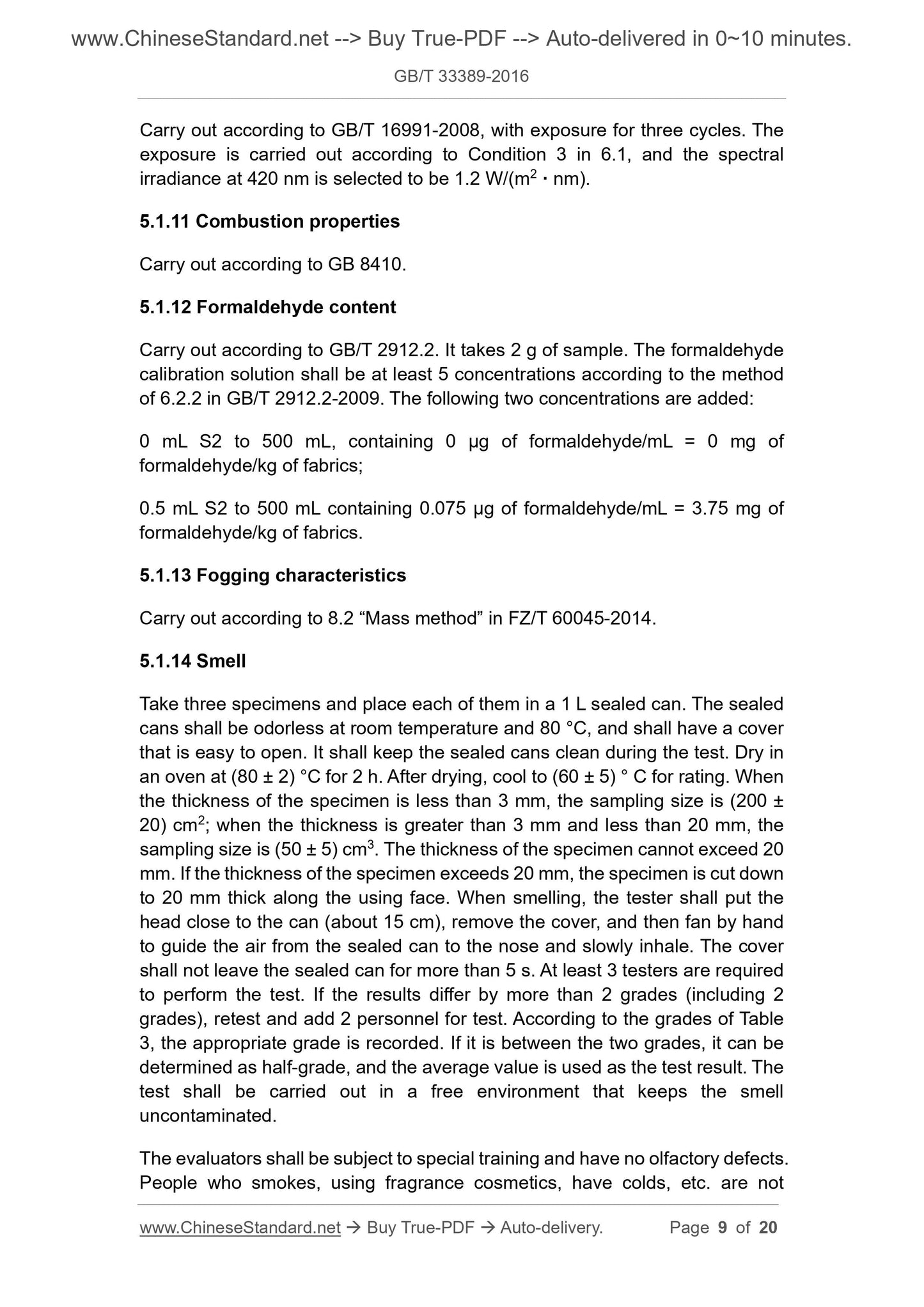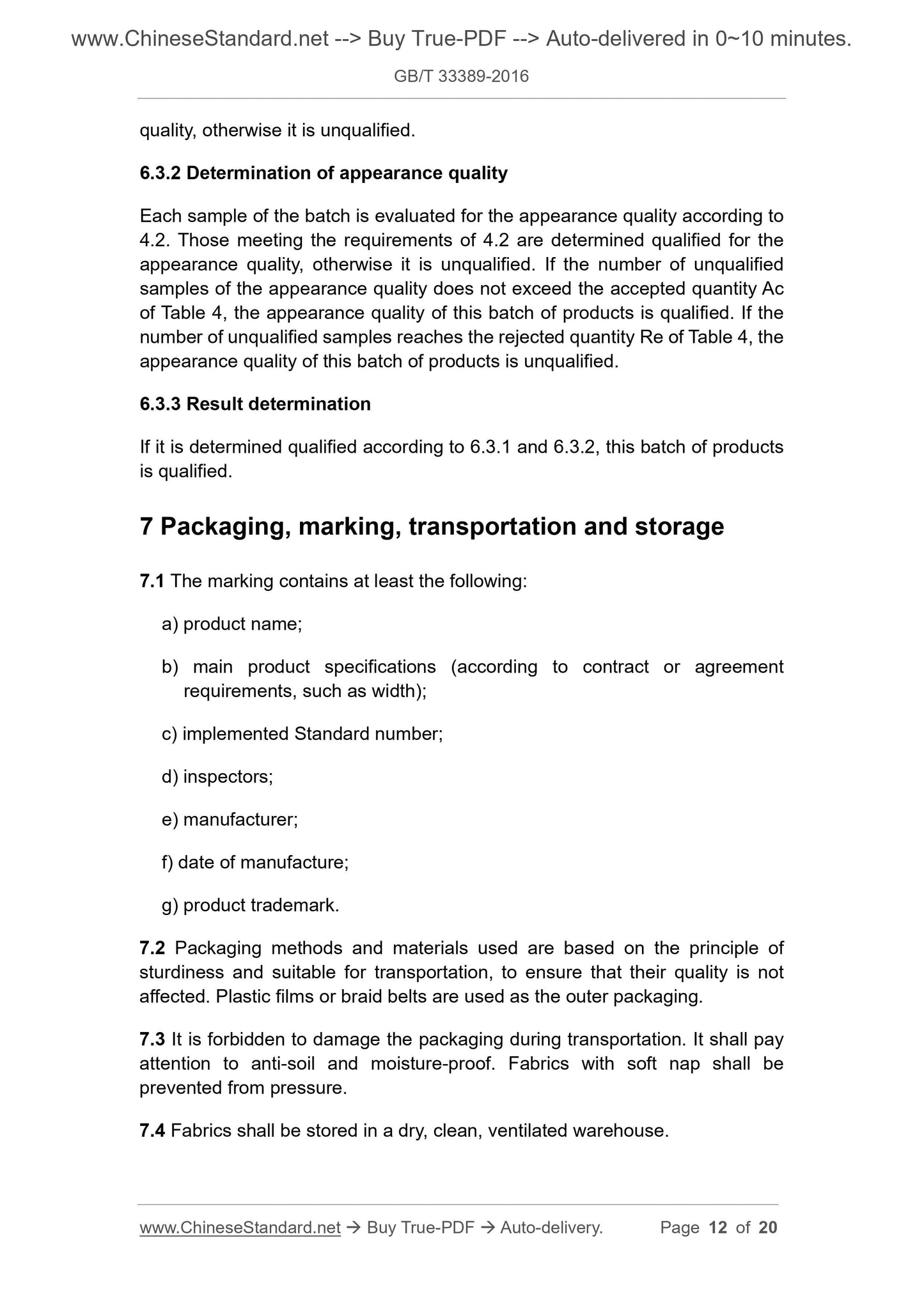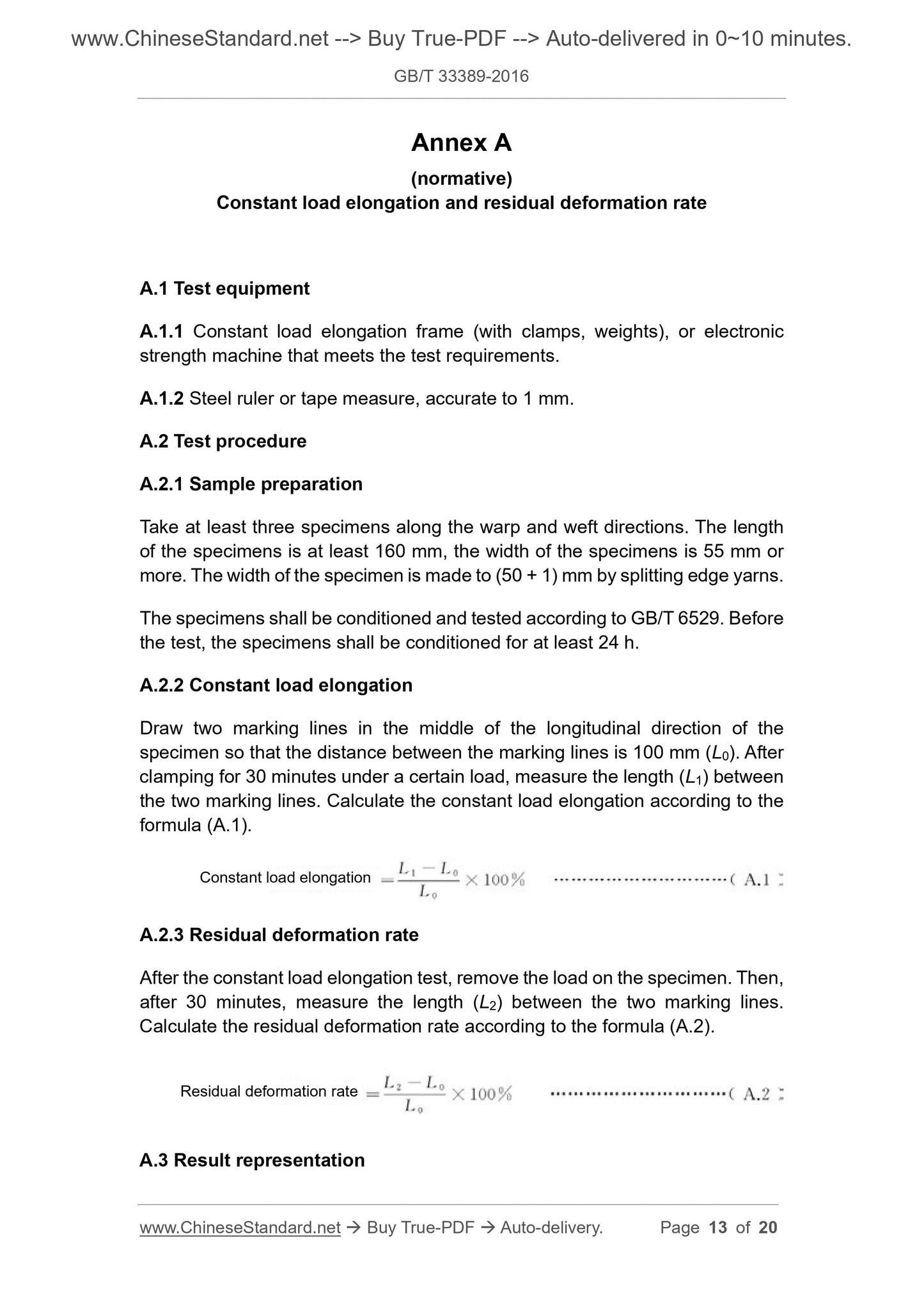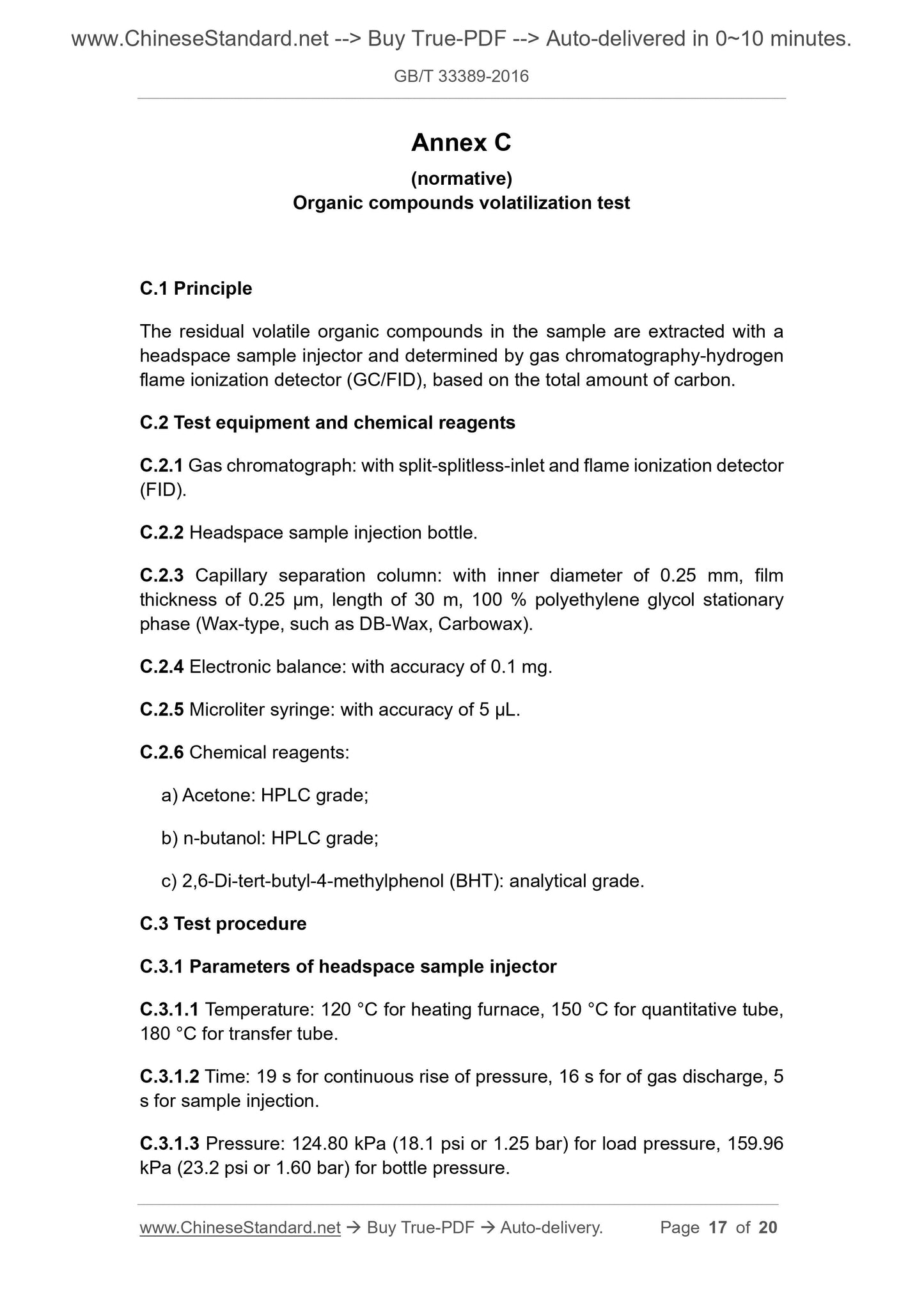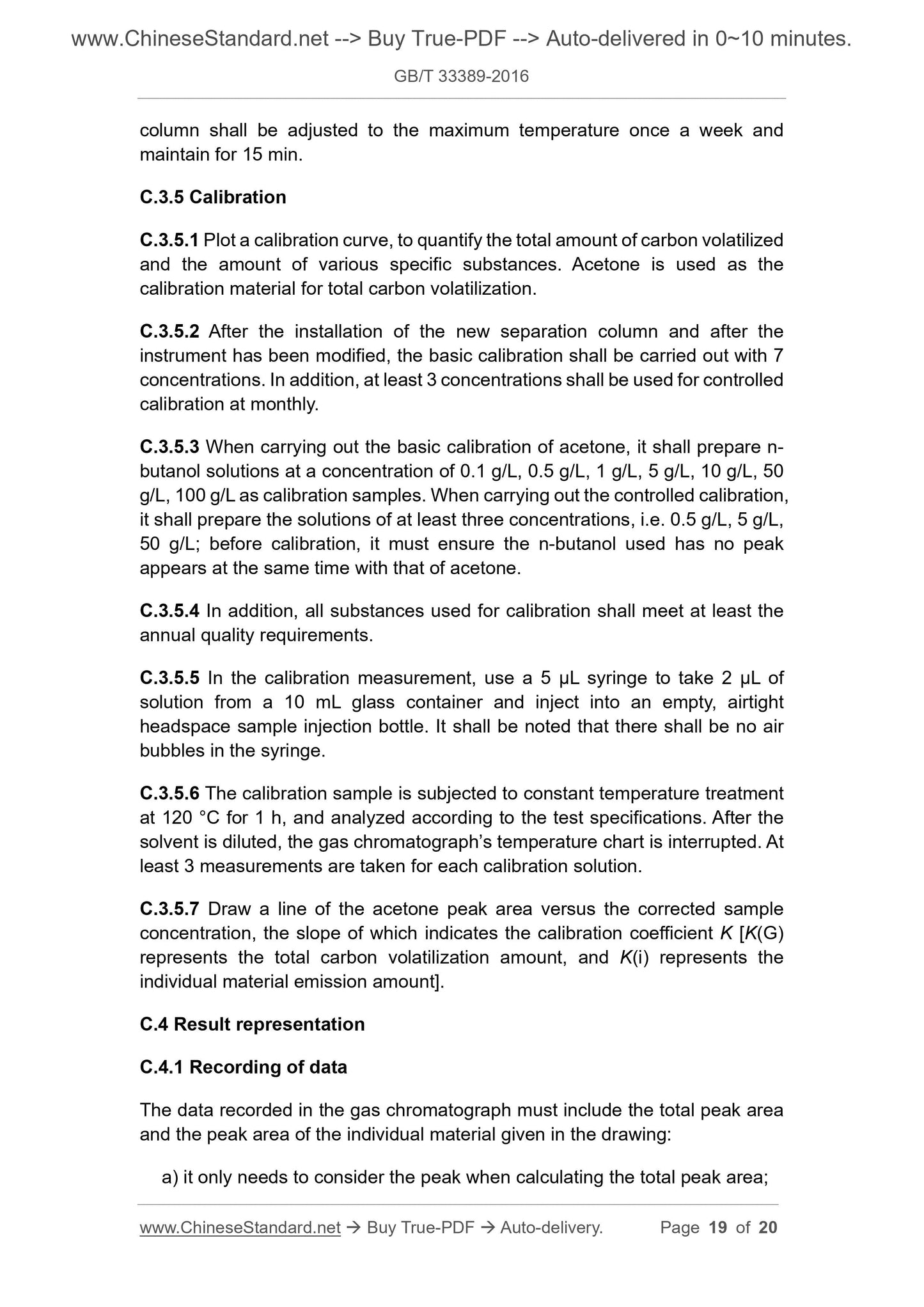1
/
of
10
PayPal, credit cards. Download editable-PDF and invoice in 1 second!
GB/T 33389-2016 English PDF (GBT33389-2016)
GB/T 33389-2016 English PDF (GBT33389-2016)
Regular price
$150.00 USD
Regular price
Sale price
$150.00 USD
Unit price
/
per
Shipping calculated at checkout.
Couldn't load pickup availability
Delivery: 3 seconds. Download true-PDF + Invoice.
Get QUOTATION in 1-minute: Click GB/T 33389-2016
Historical versions: GB/T 33389-2016
Preview True-PDF (Reload/Scroll if blank)
GB/T 33389-2016: Woven fabrics and woven composite fabrics for automotive interior
GB/T 33389-2016
NATIONAL STANDARD OF THE
PEOPLE’S REPUBLIC OF CHINA
ICS 59.080.30
W 59
Woven fabrics and woven
composite fabrics for automotive interior
ISSUED ON: DECEMBER 30, 2016
IMPLEMENTED ON: JULY 01, 2017
Issued by: General Administration of Quality Supervision, Inspection and
Quarantine of the People's Republic of China;
Standardization Administration of the People's Republic of
China.
Table of Contents
Foreword ... 3
1 Scope ... 4
2 Normative references ... 4
3 Terms and definitions ... 5
4 Technical requirements and quality assessment ... 6
5 Test methods ... 7
6 Inspection rules ... 11
7 Packaging, marking, transportation and storage ... 12
Annex A (normative) Constant load elongation and residual deformation rate
... 13
Annex B (normative) Schopper abrasion resistance ... 15
Annex C (normative) Organic compounds volatilization test ... 17
Woven fabrics and woven
composite fabrics for automotive interior
1 Scope
This Standard specifies the technical requirements, inspection methods,
inspection rules, marking, packaging, transportation and storage of woven
fabrics and woven composite fabrics for automotive interior.
This Standard applies to woven fabrics and woven composite fabrics that are
mainly made of textile fiber raw materials and processed by woven technology,
for automotive interiors such as automobile seats and door panels.
2 Normative references
The following referenced documents are indispensable for the application of
this document. For dated references, only the edition cited applies. For undated
references, the latest edition of the referenced document (including any
amendments) applies.
GB/T 250 Textiles - Tests for colour fastness - Grey scale for assessing
change in colour
GB/T 2912.2-2009 Textiles - Determination of formaldehyde - Part 2:
Released formaldehyde (vapour absorption)
GB/T 3820 Determination of thickness of textiles and textile products
GB/T 3917.3 Textiles - Tear properties of fabrics - Part 3: Determination of
tear force of trapezoid-shaped test specimens
GB/T 3920 Textiles - Tests for colour fastness - Colour fastness to rubbing
GB/T 3923.1 Textiles - Tensile properties of fabrics - Part 1: Determination of
maximum force and elongation at maximum force using the strip method
GB/T 4666 Textiles - Fabrics - Determination of width and length
GB/T 4669-2008 Textiles - Woven fabrics - Determination of mass per unit
length and mass per unit area
GB/T 4745 Textiles - Testing and evaluation for water resistance - Spray test
method
GB/T 6529 Textiles - Standard atmospheres for conditioning and testing
GB/T 8170 Rules of rounding off for numerical values and expression and
judgement of limiting values
GB 8410 Flammability of automotive interior materials
GB/T 13773.1 Textiles - Seam tensile properties of fabrics and made-up
textile articles - Part 1: Determination of maximum force to seam rupture
using the strip method
GB/T 14801 Test method for skewness and bow in woven and knitted fabrics
GB/T 16991-2008 Textiles - Test for colour fastness - Colour fastness and
ageing to artificial light at high temperatures: Xenon arc
GB 18186-2000 Fermented soy sauce
GB/T 19977 Textiles - Oil repellency - Hydrocarbon resistance test
GB/T 21196.2 Textiles - Determination of the abrasion resistance of fabrics
by the Martindale method - Part 2: Determination of specimen breakdown
FZ/T 01118 Textiles - Testing and evaluation for anti-soil properties - Soil
release
FZ/T 01128 Textiles - Determination of abrasion resistance - Double-head
method
FZ/T 60045-2014 Textile trim materials in the interior of automobiles - Test
method for fogging characteristics
3 Terms and definitions
For the purpose of this document, the following terms and definitions apply.
3.1
woven laminated fabrics for automotive interior
Composite fabrics of two or more layers, made by bonding the woven fabrics
to urethane foams or knitted fabrics, nonwoven fabrics, etc., used for
automotive interiors.
at least 24 h.
Two sets of specimens are taken from the fabric to be tested, in which one set
is warp specimens and one set is weft specimens. Each set of specimens
contains three pieces of specimens. It shall avoid wrinkles and defects. The
specimen shall be at least 150 mm away from the edge of the cloth. It shall
ensure that the specimens are evenly distributed on the sample. Each
specimen has a size of 200 mm × 50 mm. Along the length of the specimen,
manually peel it off at least 40 mm, and respectively clamp them on the upper
and lower clamps of the CRE tensile testing machine. The spacing of the upper
and lower clamps is set to 50 mm. The specimen is stretched to complete
separation at the test speed of 100 mm/min. Record the curve. The 1/4 portion
of each of the front and back of the graph is removed, and the average value
of the peaks of the middle 1/2 portion is taken. The test result is expressed as
the arithmetic mean of the three specimens. The data is rounded off according
to the method of GB/T 8170, and the calculation result retains one decimal
place.
5.1.8 Abrasion resistance
5.1.8.1 Martindale method
Carry out according to GB/T 21196.2. The total mass of loading block and
specimen clamp assembly is (795 ± 7) g. During the abrasion test, the nominal
pressure applied to the specimen is 12 kPa, and the test end is the specified
number of abrasions. Number of abrasions: 20000 times for the main material
of seats, 35000 times for seat accessories, 15000 times for door panels. After
the test is completed, the change in color of the abrasion area of the specimen
is evaluated according to GB/T 250, and the appearance change of the surface
of the specimen is recorded.
5.1.8.2 Taber abrasion resistance
Carry out according to FZ/T 01128, with CS-10 abrasion wheel, 500 g of load,
1000 times of abrasion. Evaluate the damage of the specimen.
5.1.8.3 Shawl abrasion resistance
Carry out according to Annex B. 1000 times for seat fabrics and 500 times for
door panel fabrics.
5.1.9 Color fastness to rubbing
Carry out according to GB/T 3920.
5.1.10 Color fastness to light
Carry out according to GB/T 16991-2008, with exposure for three cycles. The
exposure is carried out according to Condition 3 in 6.1, and the spectral
irradiance at 420 nm is selected to be 1.2 W/(m2 · nm).
5.1.11 Combustion properties
Carry out according to GB 8410.
5.1.12 Formaldehyde content
Carry out according to GB/T 2912.2. It takes 2 g of sample. The formaldehyde
calibration solution shall be at least 5 concentrations according to the method
of 6.2.2 in GB/T 2912.2-2009. The following two concentrations are added:
0 mL S2 to 500 mL, containing 0 μg of formaldehyde/mL = 0 mg of
formaldehyde/kg of fabrics;
0.5 mL S2 to 500 mL containing 0.075 μg of formaldehyde/mL = 3.75 mg of
formaldehyde/kg of fabrics.
5.1.13 Fogging characteristics
Carry out according to 8.2 “Mass method” in FZ/T 60045-2014.
5.1.14 Smell
Take three specimens and place each of them in a 1 L sealed can. The sealed
cans shall be odorless at room temperature and 80 °C, and shall have a cover
that is easy to open. It shall keep the sealed cans clean during the test. Dry in
an oven at (80 ± 2) °C for 2 h. After drying, cool to (60 ± 5) ° C for rating. When
the thickness of the specimen is less than 3 mm, the sampling size is (200 ±
20) cm2; when the thickness is...
Get QUOTATION in 1-minute: Click GB/T 33389-2016
Historical versions: GB/T 33389-2016
Preview True-PDF (Reload/Scroll if blank)
GB/T 33389-2016: Woven fabrics and woven composite fabrics for automotive interior
GB/T 33389-2016
NATIONAL STANDARD OF THE
PEOPLE’S REPUBLIC OF CHINA
ICS 59.080.30
W 59
Woven fabrics and woven
composite fabrics for automotive interior
ISSUED ON: DECEMBER 30, 2016
IMPLEMENTED ON: JULY 01, 2017
Issued by: General Administration of Quality Supervision, Inspection and
Quarantine of the People's Republic of China;
Standardization Administration of the People's Republic of
China.
Table of Contents
Foreword ... 3
1 Scope ... 4
2 Normative references ... 4
3 Terms and definitions ... 5
4 Technical requirements and quality assessment ... 6
5 Test methods ... 7
6 Inspection rules ... 11
7 Packaging, marking, transportation and storage ... 12
Annex A (normative) Constant load elongation and residual deformation rate
... 13
Annex B (normative) Schopper abrasion resistance ... 15
Annex C (normative) Organic compounds volatilization test ... 17
Woven fabrics and woven
composite fabrics for automotive interior
1 Scope
This Standard specifies the technical requirements, inspection methods,
inspection rules, marking, packaging, transportation and storage of woven
fabrics and woven composite fabrics for automotive interior.
This Standard applies to woven fabrics and woven composite fabrics that are
mainly made of textile fiber raw materials and processed by woven technology,
for automotive interiors such as automobile seats and door panels.
2 Normative references
The following referenced documents are indispensable for the application of
this document. For dated references, only the edition cited applies. For undated
references, the latest edition of the referenced document (including any
amendments) applies.
GB/T 250 Textiles - Tests for colour fastness - Grey scale for assessing
change in colour
GB/T 2912.2-2009 Textiles - Determination of formaldehyde - Part 2:
Released formaldehyde (vapour absorption)
GB/T 3820 Determination of thickness of textiles and textile products
GB/T 3917.3 Textiles - Tear properties of fabrics - Part 3: Determination of
tear force of trapezoid-shaped test specimens
GB/T 3920 Textiles - Tests for colour fastness - Colour fastness to rubbing
GB/T 3923.1 Textiles - Tensile properties of fabrics - Part 1: Determination of
maximum force and elongation at maximum force using the strip method
GB/T 4666 Textiles - Fabrics - Determination of width and length
GB/T 4669-2008 Textiles - Woven fabrics - Determination of mass per unit
length and mass per unit area
GB/T 4745 Textiles - Testing and evaluation for water resistance - Spray test
method
GB/T 6529 Textiles - Standard atmospheres for conditioning and testing
GB/T 8170 Rules of rounding off for numerical values and expression and
judgement of limiting values
GB 8410 Flammability of automotive interior materials
GB/T 13773.1 Textiles - Seam tensile properties of fabrics and made-up
textile articles - Part 1: Determination of maximum force to seam rupture
using the strip method
GB/T 14801 Test method for skewness and bow in woven and knitted fabrics
GB/T 16991-2008 Textiles - Test for colour fastness - Colour fastness and
ageing to artificial light at high temperatures: Xenon arc
GB 18186-2000 Fermented soy sauce
GB/T 19977 Textiles - Oil repellency - Hydrocarbon resistance test
GB/T 21196.2 Textiles - Determination of the abrasion resistance of fabrics
by the Martindale method - Part 2: Determination of specimen breakdown
FZ/T 01118 Textiles - Testing and evaluation for anti-soil properties - Soil
release
FZ/T 01128 Textiles - Determination of abrasion resistance - Double-head
method
FZ/T 60045-2014 Textile trim materials in the interior of automobiles - Test
method for fogging characteristics
3 Terms and definitions
For the purpose of this document, the following terms and definitions apply.
3.1
woven laminated fabrics for automotive interior
Composite fabrics of two or more layers, made by bonding the woven fabrics
to urethane foams or knitted fabrics, nonwoven fabrics, etc., used for
automotive interiors.
at least 24 h.
Two sets of specimens are taken from the fabric to be tested, in which one set
is warp specimens and one set is weft specimens. Each set of specimens
contains three pieces of specimens. It shall avoid wrinkles and defects. The
specimen shall be at least 150 mm away from the edge of the cloth. It shall
ensure that the specimens are evenly distributed on the sample. Each
specimen has a size of 200 mm × 50 mm. Along the length of the specimen,
manually peel it off at least 40 mm, and respectively clamp them on the upper
and lower clamps of the CRE tensile testing machine. The spacing of the upper
and lower clamps is set to 50 mm. The specimen is stretched to complete
separation at the test speed of 100 mm/min. Record the curve. The 1/4 portion
of each of the front and back of the graph is removed, and the average value
of the peaks of the middle 1/2 portion is taken. The test result is expressed as
the arithmetic mean of the three specimens. The data is rounded off according
to the method of GB/T 8170, and the calculation result retains one decimal
place.
5.1.8 Abrasion resistance
5.1.8.1 Martindale method
Carry out according to GB/T 21196.2. The total mass of loading block and
specimen clamp assembly is (795 ± 7) g. During the abrasion test, the nominal
pressure applied to the specimen is 12 kPa, and the test end is the specified
number of abrasions. Number of abrasions: 20000 times for the main material
of seats, 35000 times for seat accessories, 15000 times for door panels. After
the test is completed, the change in color of the abrasion area of the specimen
is evaluated according to GB/T 250, and the appearance change of the surface
of the specimen is recorded.
5.1.8.2 Taber abrasion resistance
Carry out according to FZ/T 01128, with CS-10 abrasion wheel, 500 g of load,
1000 times of abrasion. Evaluate the damage of the specimen.
5.1.8.3 Shawl abrasion resistance
Carry out according to Annex B. 1000 times for seat fabrics and 500 times for
door panel fabrics.
5.1.9 Color fastness to rubbing
Carry out according to GB/T 3920.
5.1.10 Color fastness to light
Carry out according to GB/T 16991-2008, with exposure for three cycles. The
exposure is carried out according to Condition 3 in 6.1, and the spectral
irradiance at 420 nm is selected to be 1.2 W/(m2 · nm).
5.1.11 Combustion properties
Carry out according to GB 8410.
5.1.12 Formaldehyde content
Carry out according to GB/T 2912.2. It takes 2 g of sample. The formaldehyde
calibration solution shall be at least 5 concentrations according to the method
of 6.2.2 in GB/T 2912.2-2009. The following two concentrations are added:
0 mL S2 to 500 mL, containing 0 μg of formaldehyde/mL = 0 mg of
formaldehyde/kg of fabrics;
0.5 mL S2 to 500 mL containing 0.075 μg of formaldehyde/mL = 3.75 mg of
formaldehyde/kg of fabrics.
5.1.13 Fogging characteristics
Carry out according to 8.2 “Mass method” in FZ/T 60045-2014.
5.1.14 Smell
Take three specimens and place each of them in a 1 L sealed can. The sealed
cans shall be odorless at room temperature and 80 °C, and shall have a cover
that is easy to open. It shall keep the sealed cans clean during the test. Dry in
an oven at (80 ± 2) °C for 2 h. After drying, cool to (60 ± 5) ° C for rating. When
the thickness of the specimen is less than 3 mm, the sampling size is (200 ±
20) cm2; when the thickness is...
Share
